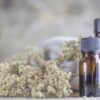What do salmon, broccoli, grapes and low-fat milk all have in common? Each of these foods have special medicinal properties that can help sufferers of osteoarthritis (OA) ease joint pain and inflammation without harmful side effects.
Osteoarthritis, a degenerative joint disease, is the most common form of arthritis in the U.S., affecting more than 27 million people. It occurs when the protective cartilage on the ends of bones wears down over time, leading to irritation, pain (as bone rubs on bone), swelling and loss of motion. Although OA can damage any joint in the body, the disorder most commonly affects joints in the hands, knees, hips and spine. The onset of OA is gradual, and usually begins after age 40. It is caused by genetics; traumatic injury, especially to the knee; obesity and other factors.
OA often gradually worsens, but there is no drug that can cure it. Pain medications — ranging from topical creams to injections — can offer symptomatic relief but come with side effects. But staying active, maintaining a healthy weight and making wise nutritional choices may slow progression of the disease and help improve joint pain and inflammation.
Here are 8 rules to follow:
Browse This Article
1. Keep Weight Down
 Since OA is caused by wear and tear on the joints, the more you weigh, the more your joints suffer. “For every pound you gain, you put 4 pounds of pressure on your knees and 6 times that on your hips,” says Constance White, MD, MA, vice president for public health policy and advocacy for the Arthritis Foundation and professor of medicine and pediatrics at the George Washington School of Medicine and Health Sciences in Washington, DC. Experts also believe that fat tissue triggers chronic inflammation and worsens the existing swelling and tenderness in arthritic joints. According to the Framingham Osteoarthritis Study, women who lost as little as 11 pounds during the study period reduced their risk of developing knee osteoarthritis by 50%.
Since OA is caused by wear and tear on the joints, the more you weigh, the more your joints suffer. “For every pound you gain, you put 4 pounds of pressure on your knees and 6 times that on your hips,” says Constance White, MD, MA, vice president for public health policy and advocacy for the Arthritis Foundation and professor of medicine and pediatrics at the George Washington School of Medicine and Health Sciences in Washington, DC. Experts also believe that fat tissue triggers chronic inflammation and worsens the existing swelling and tenderness in arthritic joints. According to the Framingham Osteoarthritis Study, women who lost as little as 11 pounds during the study period reduced their risk of developing knee osteoarthritis by 50%.
2. Get More Omega-3s
 OA sufferers can make key dietary changes that may help to reduce symptoms. Says Dr. White, “When it comes to OA, the most promising research is around omega-3 fatty acids. There is evidence they may ease arthritis pain and inflammation.” A recent study conducted at Duke University and published in the Annals of Rheumatic Diseases found that mice who were given omega-3 fatty acid supplements had healthier joints than those fed diets high in saturated fats and omega-6 fatty acids. (Omegas-6s are found in vegetable oils, nuts and seeds.)
OA sufferers can make key dietary changes that may help to reduce symptoms. Says Dr. White, “When it comes to OA, the most promising research is around omega-3 fatty acids. There is evidence they may ease arthritis pain and inflammation.” A recent study conducted at Duke University and published in the Annals of Rheumatic Diseases found that mice who were given omega-3 fatty acid supplements had healthier joints than those fed diets high in saturated fats and omega-6 fatty acids. (Omegas-6s are found in vegetable oils, nuts and seeds.)
The best food sources of omega-3 fatty acids include cold water fish, such as salmon, herring, mackerel and tuna. While it’s not certain how much you need to eat to reap the benefits, most experts recommend at least 2 servings of omega-3-rich fish a week (a serving size is 3.5 ounces, or about the size of a deck of cards). Other foods that contain omega-3s include canola and soybean oils, flaxseed and walnuts. Brynne Aronson, an OA sufferer in Ivyland, PA, found relief when she upped her intake of omega-3 powerhouses like salmon and fish oil supplements, lost 15 pounds, got more exercise and eliminated certain foods like sugar from her diet. “It took a few months to see results. But one day I realized that my hands didn’t hurt anymore. I could open and close them, make a fist and garden without pain. It was amazing,” she says.
3. Drink More Milk
 A recent study conducted by researchers from Brigham & Women’s Hospital in Boston, and published in the journal Arthritis Care & Research, collected health, diet and behavioral data from 2,148 men and women with OA over a 4-year period. The study found that women who drank several 8-ounce glasses of fat-free or low-fat milk a week delayed the progression of osteoarthritis of the knee. (The same effect was not found in men.) By contrast, women who ate cheese during the study period saw an increase in knee OA progression, possibly due to the higher levels of saturated fat in the cheese. Yogurt did not have an impact on OA progression in either men or women.
A recent study conducted by researchers from Brigham & Women’s Hospital in Boston, and published in the journal Arthritis Care & Research, collected health, diet and behavioral data from 2,148 men and women with OA over a 4-year period. The study found that women who drank several 8-ounce glasses of fat-free or low-fat milk a week delayed the progression of osteoarthritis of the knee. (The same effect was not found in men.) By contrast, women who ate cheese during the study period saw an increase in knee OA progression, possibly due to the higher levels of saturated fat in the cheese. Yogurt did not have an impact on OA progression in either men or women.
4. Go for the Grapes
 Emerging research has shown that the polyphenols (a type of antioxidant) in grapes may help alleviate osteoarthritis pain and improve joint flexibility and overall mobility. A clinical study conducted by Texas Woman’s University and published in The Journal of the Federation of American Societies for Experimental Biology divided 72 men and women with knee osteoarthritis into 2 groups. Half of the study participants were asked to consume grapes in the form of a whole grape freeze-dried powder for 16 weeks; the others were given a placebo powder. Those who consumed a grape-enriched diet (equivalent to 1-1/2 cups of grapes a day) had a decrease in self-reported pain related to activity and an overall decrease in total knee symptoms. Says lead investigator Shanil Juma, PhD: “Consuming grapes along with other foods high in polyphenols — such as fruits like berries, vegetables, herbs and green tea — can help reduce inflammation” and be part of an overall OA treatment plan. (For the 100 richest dietary sources of polyphenols, see this list in the European Journal of Clinical Nutrition.)
Emerging research has shown that the polyphenols (a type of antioxidant) in grapes may help alleviate osteoarthritis pain and improve joint flexibility and overall mobility. A clinical study conducted by Texas Woman’s University and published in The Journal of the Federation of American Societies for Experimental Biology divided 72 men and women with knee osteoarthritis into 2 groups. Half of the study participants were asked to consume grapes in the form of a whole grape freeze-dried powder for 16 weeks; the others were given a placebo powder. Those who consumed a grape-enriched diet (equivalent to 1-1/2 cups of grapes a day) had a decrease in self-reported pain related to activity and an overall decrease in total knee symptoms. Says lead investigator Shanil Juma, PhD: “Consuming grapes along with other foods high in polyphenols — such as fruits like berries, vegetables, herbs and green tea — can help reduce inflammation” and be part of an overall OA treatment plan. (For the 100 richest dietary sources of polyphenols, see this list in the European Journal of Clinical Nutrition.)
5. Don’t Forget Those Veggies
 Studies have found that sulforaphane, a compound in broccoli and other cruciferous vegetables — such as cauliflower, kale, cabbage and Brussels sprouts — may block the enzymes linked to joint damage and ease inflammation. Broccoli is also rich in vitamin K, which some studies suggest helps maintain strong bones in the elderly. How much of the green stuff do you need? The Arthritis Foundation recommends 2 to 3 cups of vegetables per day, primarily from the dark green (kale, collard greens, spinach) and orange (sweet potatoes, squash, carrots) families. These are highest in antioxidants, which help reduce the pain and swelling associated with OA.
Studies have found that sulforaphane, a compound in broccoli and other cruciferous vegetables — such as cauliflower, kale, cabbage and Brussels sprouts — may block the enzymes linked to joint damage and ease inflammation. Broccoli is also rich in vitamin K, which some studies suggest helps maintain strong bones in the elderly. How much of the green stuff do you need? The Arthritis Foundation recommends 2 to 3 cups of vegetables per day, primarily from the dark green (kale, collard greens, spinach) and orange (sweet potatoes, squash, carrots) families. These are highest in antioxidants, which help reduce the pain and swelling associated with OA.
6. Consider Supplements
 Glucosamine and chondroitin sulfate are the most common supplements for OA, but experts are divided on their efficacy. Some sufferers experience great relief, while others don’t. The recent Glucosamine/Chondroitin Arthritis Intervention Trial surveyed 662 participants with moderate to severe knee osteoarthritis over a 2-year period. Researchers found that the OA sufferers who took glucosamine, chondroitin sulfate or a combination of the two experienced some improvement in pain and joint function — but not significantly more relief than those who took the prescription drug celecoxib or a placebo. Glucosamine and chondroitin supplements sometimes cause side effects such as nausea, heartburn and diarrhea; but taking them with food seems to ease these problems.
Glucosamine and chondroitin sulfate are the most common supplements for OA, but experts are divided on their efficacy. Some sufferers experience great relief, while others don’t. The recent Glucosamine/Chondroitin Arthritis Intervention Trial surveyed 662 participants with moderate to severe knee osteoarthritis over a 2-year period. Researchers found that the OA sufferers who took glucosamine, chondroitin sulfate or a combination of the two experienced some improvement in pain and joint function — but not significantly more relief than those who took the prescription drug celecoxib or a placebo. Glucosamine and chondroitin supplements sometimes cause side effects such as nausea, heartburn and diarrhea; but taking them with food seems to ease these problems.
Dr. White also suggests that OA sufferers try magnesium supplements. Most Americans are deficient in this nutrient, as the best dietary sources — pumpkin and sunflower seeds — aren’t staples of our diet. But a daily magnesium supplement can help boost bone mineralization and strength and help relieve joint pain. Turmeric and ginger also have been shown to have anti-inflammatory properties and are available in extracts, capsules and other formulations. Speak to your doctor before taking any supplements as they may have an adverse reaction when combined with prescription or over-the-counter drugs.
7. Up Your Intake of Vitamin D
 Having a deficiency of vitamin D can cause problems for those with osteoarthritis, leading to cartilage loss, greater knee pain and difficulty walking. Low vitamin D levels (which can be determined by a blood test) have also been shown to speed the progression of the disease.
Having a deficiency of vitamin D can cause problems for those with osteoarthritis, leading to cartilage loss, greater knee pain and difficulty walking. Low vitamin D levels (which can be determined by a blood test) have also been shown to speed the progression of the disease.
Vitamin D can be found in fortified foods such as dairy products, orange juice, soy milk and cereals, and in supplements. The Office of Dietary Supplements at the National Institutes of Health recommends 600 international units (IU) of daily vitamin D for adults between the ages of 19 and 70. Adults over 70 should get 800 IU a day. The Vitamin D Council — a nonprofit organization that works to educate the public about vitamin D — recommends a much higher daily intake of 5,000 IU for adults; while the Institute of Medicine notes that an Upper Intake Level of 4,000 IU is acceptable. (See Vitamin D: Pros and Cons for more information.)
8. Beware the Nightshades
 For generations, OA sufferers and many naturopaths have claimed an association between worsening OA symptoms and the family of vegetables known as nightshades, which include eggplant, peppers, potatoes and tomatoes. There is no scientific proof that these veggies (dubbed nightshades because most prefer to grow in the shade and some flower at night) can aggravate OA. However, Dr. White points out that if OA sufferers experience a reduction of symptoms and feel better by eliminating these foods, they should stick with what works. “If people can move more and feel better, their condition will improve, whether or not it’s actually due to the elimination of these foods.” Says Aronson: “In the past 6 to 8 months, I’ve added some sugar and nightshade foods — like spicy peppers — back into my diet. Sure enough, I’m seeing the pain gradually return to my hands and knuckles.” Seeking to feel good again, Aronson will continue to stay active, make some dietary changes and remain aware of how certain foods affect her condition.
For generations, OA sufferers and many naturopaths have claimed an association between worsening OA symptoms and the family of vegetables known as nightshades, which include eggplant, peppers, potatoes and tomatoes. There is no scientific proof that these veggies (dubbed nightshades because most prefer to grow in the shade and some flower at night) can aggravate OA. However, Dr. White points out that if OA sufferers experience a reduction of symptoms and feel better by eliminating these foods, they should stick with what works. “If people can move more and feel better, their condition will improve, whether or not it’s actually due to the elimination of these foods.” Says Aronson: “In the past 6 to 8 months, I’ve added some sugar and nightshade foods — like spicy peppers — back into my diet. Sure enough, I’m seeing the pain gradually return to my hands and knuckles.” Seeking to feel good again, Aronson will continue to stay active, make some dietary changes and remain aware of how certain foods affect her condition.
For More Information
How to Ease Your Arthritis Pain With Simple Food Swaps (Cleveland Clinic)
Turmeric Curcumin and Osteoarthritis (NutritionFacts.org video)
Sugary Soft Drinks Worsen Osteoarthritis in Men (Everyday Health)







